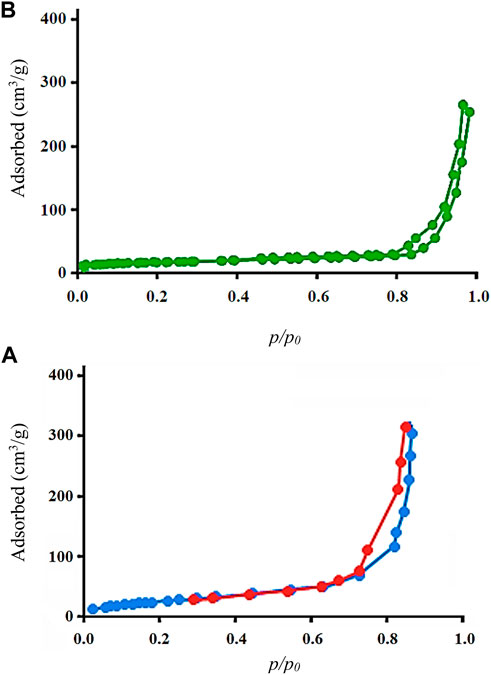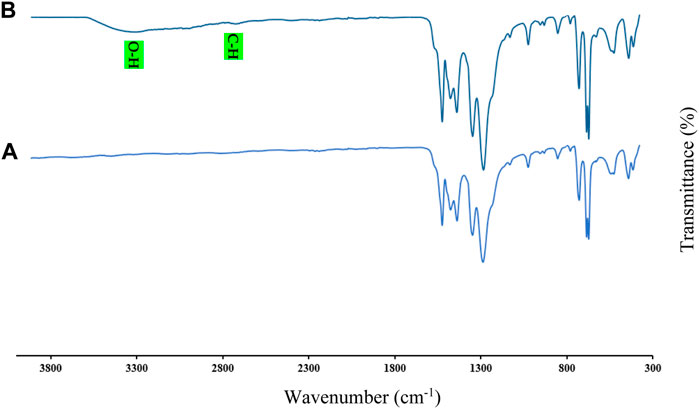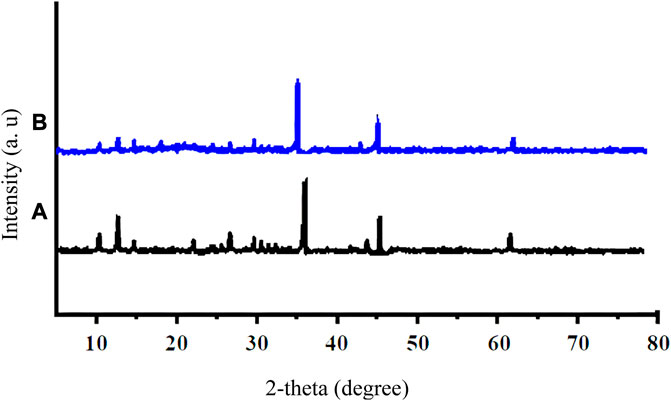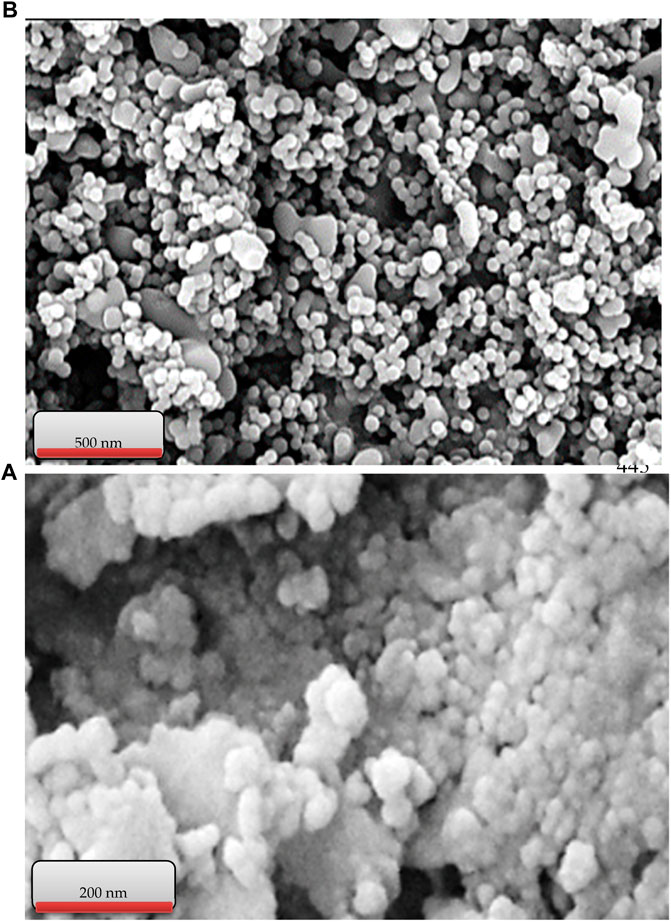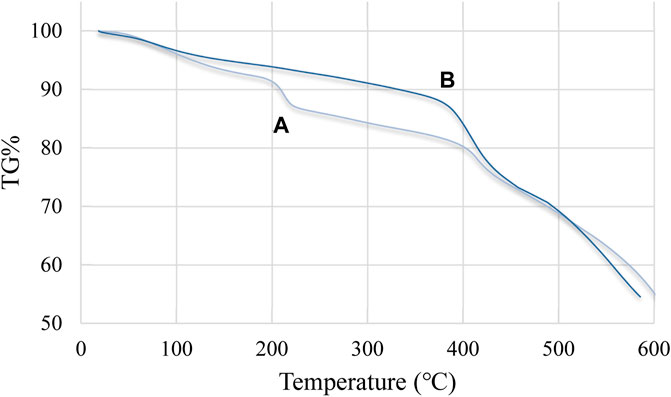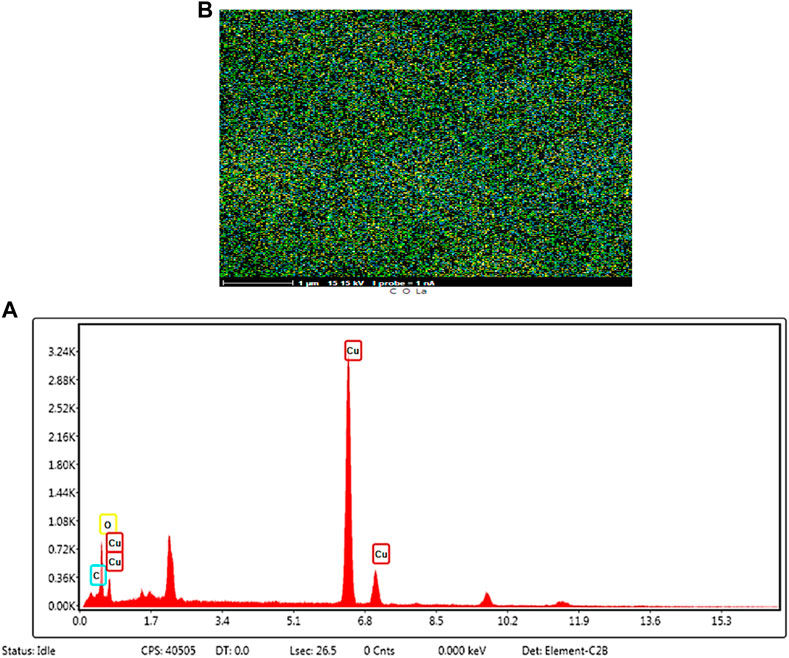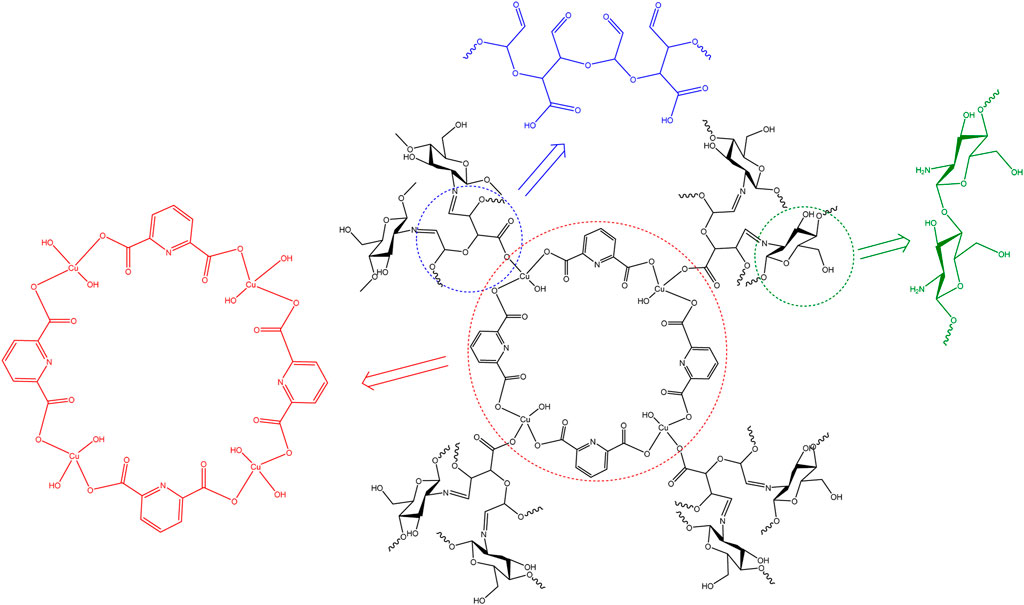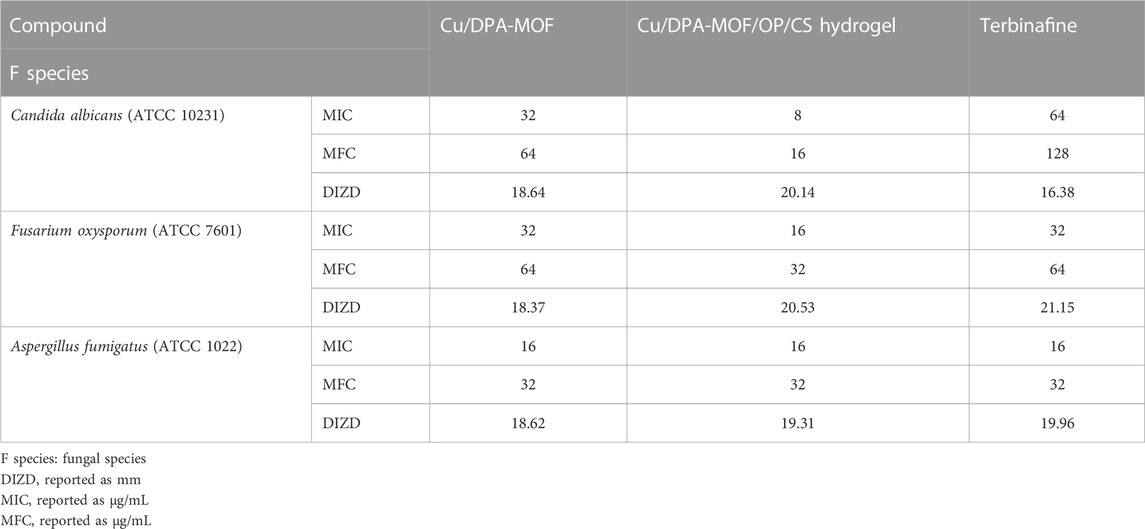- 1College of Dentistry, Al-Mustaqbal University, Babylon, Iraq
- 2College of Technical Engineering, Imam Ja’afar Al-Sadiq University, Al-Muthanna, Iraq
- 3Department of Medical Laboratories Technology, Al-Nisour University College, Al-Mansour, Iraq
- 4College of Pharmacy, Al-Ayen University, Nasiriyah, Thi-Qar, Iraq
- 5Department of Medical Engineering, Al-Esraa University College, Baghdad, Iraq
- 6College of Health and Medical Technology, National University of Science and Technology, Nasiriyah, Thi-Qar, Iraq
- 7Department of Clinical Laboratory Sciences, College of Applied Medical Sciences, King Khalid University, Abha, Saudi Arabia
- 8Technical Engineering Department College of Technical Engineering, The Islamic University, Najaf, Iraq
- 9Department of Physics, College of Science, University of Kufa, Kufa, Iraq
- 10Medical Technical College, College of Pharmacy, University of Al-Ameed, Karbala, Iraq
Today, with the indiscriminate use of antibiotics, we face the resistance of some bacterial strains against some antibiotics. Therefore, it is essential to report and synthesize new compounds with antimicrobial properties. A novel copper/dipicolinic acid–metal–organic framework cross-linked oxidized pectin and chitosan (Cu/DPA-MOF/OP/CS) hydrogel polymer was synthesized under environmental conditions with the controllable process, which uses biodegradable polymer compounds such as pectin and chitosan in its structure. The efficient physicochemical features of the synthesized Cu/DPA-MOF/OP/CS hydrogel using SEM, FT-IR, TGA, BET, XRD, and EDS/mapping were identified and confirmed. The newly synthesized Cu/DPA-MOF/OP/CS hydrogel showed activity against Gram-positive and Gram-negative bacterial strains and fungal species, and significant antibacterial and antifungal properties were observed. In antibacterial activity, the MIC against Gram-positive species was in the range of 16–128 mg/mL, the MIC against Gram-negative species was in the range of 64–256 mg/mL, and the MIC against fungal species was in the range of 128–512 mg/mL. In antimicrobial evaluations, in addition to the MIC test, the MBC test, the MFC test, and the IZD test were performed, and the results were reported. The results were compared with commercial antibiotics in the market. Development of novel nanostructures based on hydrogel polymers with distinctive functionality can affect the performance of these nanostructures in different areas.
1 Introduction
In recent years, the widespread and generally unnecessary use of drugs has caused the resistance of a wide range of pathogenic microbes. This has resulted in threats and health concerns, increased treatment costs, and patient deaths (Otter et al., 2015). Providing new compounds with antimicrobial properties is one of the goals suggested to prevent these cases. As is known, nanotechnology is developing, and nanostructures can have potential activities in this field. Various nanocompounds with biological properties such as anticancer (Wani et al., 2016), anticoagulant (Zaky et al., 2023), antiviral (Balagna et al., 2021), and antimicrobial activities (Al-Jumaili et al., 2017) have been reported. The use of metals causes significant biological properties in these compounds (Khan et al., 2018; Zare et al., 2019). Copper is known as one of the transition metals of the periodic table with biological properties. So far, new complex and nanocompounds containing copper with biological properties such as antibacterial and antifungal activities have been reported (de Araújo et al., 2017; Marković et al., 2018; Dimitrijević et al., 2020; Li et al., 2023). Recently, there have been reports on the use of this metal in advanced nanocompounds such as metal–organic frameworks (MOFs) with biological properties (Jo et al., 2019; Sun et al., 2021; Lin et al., 2023). The unique properties of MOF compounds have attracted the attention of biomedical aspects (Al-Rowaili et al., 2018; Giliopoulos et al., 2020). Excellent physical and chemical properties, such as high porosity, high thermal stability, and high reactivity, are the most critical features of these compounds (Razavi and Morsali, 2019; Ghanbari et al., 2020). These properties and characteristics have caused the use of these compounds to be reported as potent biomedical agents (Babucci et al., 2020; Ahmadi et al., 2021; Li et al., 2021; Han et al., 2022). Although these compounds have significant physicochemical properties, according to their applications, biocompatibility and biodegradability need to be improved.
These compounds can connect with organic polymers and create novel polymer compounds (Han et al., 2022). Today, the use of polymers in life is inevitable. Polymers have many applications, such as in the building and automotive industries, binder materials, cables and pipes, and membrane materials (Sun, 2019; Nurazzi et al., 2021; Hu et al., 2022). Polymers are also found in abundance in nature, such as DNA, cellulose, starch, pectin, and chitosan. Polymer compounds with significant properties can be produced using natural polymer compounds. For example, recently, there have been reports on the use of pectin and other compounds, such as metal–organic frameworks and hybrid materials, in synthesizing new polymers with biomedical and drug delivery applications (Rascón-Chu et al., 2019; Li et al., 2021; Kiadeh et al., 2021). Chitosan is mentioned among other natural polymers. Chitosan with numerous nanocompounds can create novel polymer compounds with high biological capabilities. Among others, we can refer to the reports of chitosan–ZnO nanoparticles, chitosan-functionalized MoS2 hybrids, halloysite nanotubes by chitosan grafting, etc., with anticancer and antimicrobial properties (Ghaffari et al., 2020; Kasinathan et al., 2020).
Therefore, it can be expected that a metal–organic framework containing copper and natural polymers such as chitosan and pectin can synthesize new nanostructures with its unique biological properties.
Microwave is one of the most efficient procedures for the synthesis of different materials with diverse applications (Sargazi et al., 2018). This method is not only fast, affordable, and controllable, but its operational process is also environmentally friendly. These properties have distinguished the microwave method from other conventional methods (Zheng et al., 2022).
In this study, we investigated that whether the polymer synthesized by the hydrogel method using the aforementioned materials after identifying and confirming the structure was subjected to antimicrobial evaluations such as antifungal and antibacterial evaluations.
2 Materials and methods
2.1 Materials
All materials such as copper(II) nitrate trihydrate, 2, 6-pyridine dicarboxylic acid, chitosan (10 mg/mL acetic acid: water), pectin (pectin from citrus peel, impurities ≤10% moisture), and solvents with high purity were obtained from Merck and Sigma-Aldrich. The cultures such as Mueller Hinton agar and Mueller Hinton broth were obtained from Sigma-Aldrich. The bacterial and fungal strains were obtained from American Type Culture Collection.
2.2 Synthesis of copper/dipicolinic acid–metal–organic framework cross-linked oxidized pectin and chitosan hydrogel
For the synthesis of Cu/DPA-MOF/OP/CS hydrogel, the first copper/dipicolinic acid-metal–organic framework (Cu/DPA-MOF) was synthesized as follows: in 25 mL bidet water (double distilled water), copper (II) nitrate trihydrate, as a source of metal (0.1 mmol), and dipicolinic acid, as a linker (0.1 mmol), were placed under microwave irradiation at ambient temperature for 25 min with a microwave power of 320 W. Then, the synthesized Ti/DPA-MOF, used for the next step, was isolated by nanofiltration, washed three times with bidet water and EtOH, and dried for 48 h under vacuum at ambient temperature.
In the next step, under stirring at 30°C, oxidized pectin (2 g) was dissolved in bidet water (10 mL). In another receptacle, chitosan (2 g) was dissolved in bidet water (10 mL) under the aforementioned conditions (Salama and Aziz, 2020). The synthesized Cu/DPA-MOF (300 mg) was added to the oxidized pectin solution and stirred (800 rpm) for 1 h at 30°C. The chitosan solution was added drop by drop to the Cu/DPA-MOF/oxidized pectin (Cu/DPA-MOF/OP) solution at 30°C under stirring for 1 h. Finally, the container containing the admixture was placed in water at 37°C for 4 h.
2.3 Antimicrobial studies of Cu/DPA-MOF and Cu/DPA-MOF/OP/CS hydrogel
In vitro minimum inhibitory/fungicidal/bactericidal concentrations and the disk inhibition zone diameter (DIZD) for synthesized Cu/DPA-MOF and Cu/DPA-MOF/OP/CS hydrogel were tested. In antimicrobial studies, standard guidelines reported by previous work were used (Hosseinzadegan et al., 2020; Zeraati et al., 2022). The minimum inhibitory concentration/fungicidal concentration (MIC and MFC) for antifungal studies and MIC and minimum bactericidal concentration (MBC) for antibacterial studies were reported.
2.3.1 In vitro minimum inhibitory concentration (MIC)method
For the in vitro minimum inhibitory test, concentrations of 1, 2, 4, 8,16, 32, 64, 128, 256, 512, 1024, and 2048 μg/mL of Cu/DPA-MOF and Cu/DPA-MOF/OP/CS hydrogel were dispersed in bidet water. A volume of 100 μL of the prepared concentrations was transferred to the microplate wells. Then, 100 μL of the liquid culture medium (for antibacterial investigation, Mueller Hinton broth, and for antifungal investigation, Dextrose Tryptone broth) was added. Finally, 10 μL of the bacterial/fungal suspension with the prepared concentration of 1 × 105 CFU/mL (colony-forming unit/mL) was added to the wells. The wells were incubated for a suitable period (48 h) at an appropriate temperature (37°C to check antibacterial activity and 27°C to check antifungal activity). A lower concentration that was clear was reported as MBC/MFC. It is noted that the last row of each plate was only a mixture of the culture medium and bacterial/fungal suspension as a control without derivatives (Hosseinzadegan et al., 2020; Zeraati et al., 2022). The results were averaged after three repetitions.
2.3.2 In vitro minimum fungicidal/bactericidal concentration (MFC/MBC) method
For the in vitro minimum fungicidal/bactericidal concentration test, the MIC and five diluted concentrations of the previous step were cultured on the appropriate agar culture medium (for antibacterial activity, Mueller Hinton agar, and for antifungal activity, Dextrose Tryptone agar). Then, they were incubated for a suitable period (72 h) at an appropriate temperature (37°C to check antibacterial activity and 27°C to check antifungal activity). The concentration at which bacteria/fungi did not grow was reported as the minimum fungicidal/bactericidal concentration. The results were averaged after three repetitions (Hosseinzadegan et al., 2020; Zeraati et al., 2022).
2.3.3 In vitro disk inhibition zone diameter (DIZD) method
For determining the in vitro disk inhibition zone diameter, first, bacterial/fungal species were cultured on a suitable agar culture medium (for antibacterial activity, Mueller Hinton agar and for antifungal activity, Dextrose Tryptone agar), and a disk blank was placed on it. Then, the minimum inhibitory concentrations of Cu/DPA-MOF and Cu/DPA-MOF/OP/CS hydrogel were dispersed in bidet water. A measure of 10 μL of the prepared concentration was injected into a disk blank. The plates were incubated for a suitable time (48 h) at an appropriate temperature (37°C to check antibacterial activity and 27°C to check antifungal activity). Finally, the diameter of the created halo was measured using a caliper. The results were averaged after three repetitions (Zeraati et al., 2022).
3 Results and discussion
3.1 Characterization and structure prediction of the copper/dipicolinic acid–metal–organic framework cross-linked oxidized pectin and chitosan (Cu/DPA-MOF/OP/CS) hydrogel
In two steps, the novel Cu/DPA-MOF/OP/CS hydrogel was synthesized. In the first step, Cu/DPA-MOF was synthesized using copper(II) nitrate trihydrate (0.1 mmol) and dipicolinic acid under microwave irradiation. In the second step, the Cu/DPA-MOF/OP/CS hydrogel was synthesized using Cu/DPA-MOF, oxidized pectin, and chitosan.
To characterize, confirm, and predict the structure of the Cu/DPA-MOF/OP/CS hydrogel, techniques such as N2 adsorption/desorption isotherm, FT-IR spectrum, XRD patterns, SEM images, thermal stability curve, EDS elemental analysis, and mapping graph were used.
The curves in Figure 1 show the N2 adsorption/desorption isotherm related to Cu/DPA-MOF (A) and Cu/DPA-MOF/OP/CS hydrogel (B). Based on the BET results, the specific surface area for Cu/DPA-MOF and Cu/DPA-MOF/OP/CS hydrogel was obtained as 28.200 m2/g and 37.700 m2/g, respectively. Based on previous studies, the high specific surface area is an essential factor in the reactivity, properties, and performance of nanoparticles (Asiri et al., 2022; Zeraati et al., 2022). Therefore, it can be suggested that the polymerization of Cu/DPA-MOF Cu/DPA by oxidized pectin and chitosan caused a significant increase in the specific surface area.
As is known, one of the most important analyses to identify and confirm the structure of organic compounds and polymers is the FT-IR spectrum. Absorptions related to functional groups and bonds between atoms can be recognized and confirmed using the FT-IR spectrum. The FT-IR spectra of Cu/DPA-MOF (A) and the Cu/DPA-MOF/OP/CS hydrogel (B) were prepared after the synthesis and are shown in Figure 2. In the FT-IR spectra of Cu/DPA-MOF and Cu/DPA-MOF/OP/CS hydrogel, significant absorptions such as Cu–O, C–O, C=C, C=N, and C=O were observed in regions 400–600 cm-1 (Elango et al., 2018), 1000–1100 cm-1, 1300–1400 cm-1, 1450 cm-1, and 1600 cm-1, respectively. In the FT-IR spectrum of Cu/DPA-MOF/OP/CS hydrogel, absorption related to C–H of SP3 carbons below 3000 cm-1 and O–H groups in the region of 3300 cm-1 were observed (Bakhshi et al., 2022; Jasim et al., 2022).
By XRD patterns presented in Figure 3, the size of Cu/DPA-MOF (Figure 3A) and Cu/DPA-MOF/OP/CS hydrogel (Figure 3B) was calculated using Scherrer’s method, according to the relevant equation and previous reports (Saqezi et al., 2022), and was found to be 61 and 78 nm, respectively. In XRD patterns, the planes [111], [200], and [220] related to copper nanoparticles were observed at 36°, 45°, and 62°, respectively (Gan et al., 2015; Elango et al., 2018).
Figure 4 shows the SEM images of Cu/DPA-MOF (A) and Cu/DPA-MOF/OP/CS hydrogel (B). The nano-sized synthesized compounds and the same morphology of the nanostructures are observed in the figure. Therefore, in addition to XRD patterns, SEM images confirm the nano-sized structure of synthetic compounds.
Thermal stability is one of the critical factors in the application of nanocompounds and polymers. The TGA curve of Cu/DPA-MOF (A) and Cu/DPA-MOF/OP/CS hydrogel (B), which shows their thermal stability, is presented in Figure 5. In both samples, the first weight loss is related to water loss on the surface and water enclosed in the structure, which is visible in the region around 90°C–110°C. In Cu/DPA-MOF, the observed weight loss from temperatures above 200°C to areas below 400°C can be attributed to the decomposition of main structures. Based on the thermal behavior of the Cu/DPA-MOF/OP/CS hydrogel, in the region (200°C–400°C), the structures of chitosan and oxidized pectin may have disappeared. As an important result, the Cu/DPA-MOF/OP/CS hydrogel has more thermal stability than Cu/DPA-MOF. This behavior can be attributed to the hydrogel nature of the final structures. Therefore, the Cu/DPA-MOF/OP/CS hydrogel is completely stable up to a higher temperature, and this feature can be used in various applications (Figure 6).
In order to ensure the formation of Cu/DPA-MOF/OP/CS hydrogel products, EDS elemental analysis with the mapping graph has been carried out. It is observed that the amounts of elements of carbon, oxygen, and Cu are shown in EDS analysis. In addition, the presence of these elements has been confirmed schematically in Fig 6. As an important result, the presence of these elements in the final structures is a strong evidence for the formation of the Cu/DPA-MOF/OP/CS hydrogel structure.
Using the interpreted analysis, especially FT-IR spectra, XRD patterns, and EDS elemental analysis with the mapping graph, it is suggested that the Cu/DPA-MOF/OP/CS hydrogel was synthesized in the form, as shown in Figure 7.
As shown in Figure 7, the proposed structure is consistent with the general groups observed during FT-IR spectra.
3.2 Antimicrobial effects of Cu/DPA-MOF and the Cu/DPA-MOF/OP/CS hydrogel
In the antimicrobial evaluations of Cu/DPA-MOF and the Cu/DPA-MOF/OP/CS hydrogel, cefazolin, as a commercial antibacterial drug, and terbinafine, as a commercial antifungal drug, against five Gram-negative species, five Gram-positive species, and three fungal species were tested and investigated. The results of antimicrobial activities are given in Tables 1, 2 and Table 3.
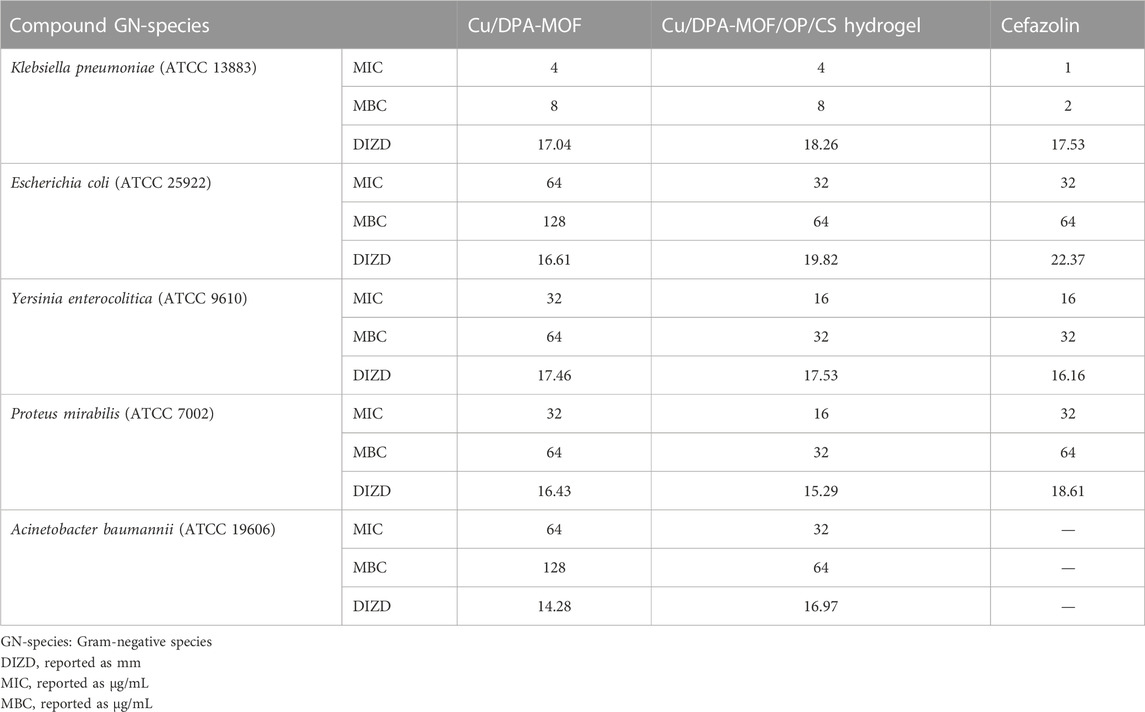
TABLE 1. Antimicrobial effects of Cu/DPA-MOF and Cu/DPA-MOF/OP/CS hydrogel on Gram-negative species.
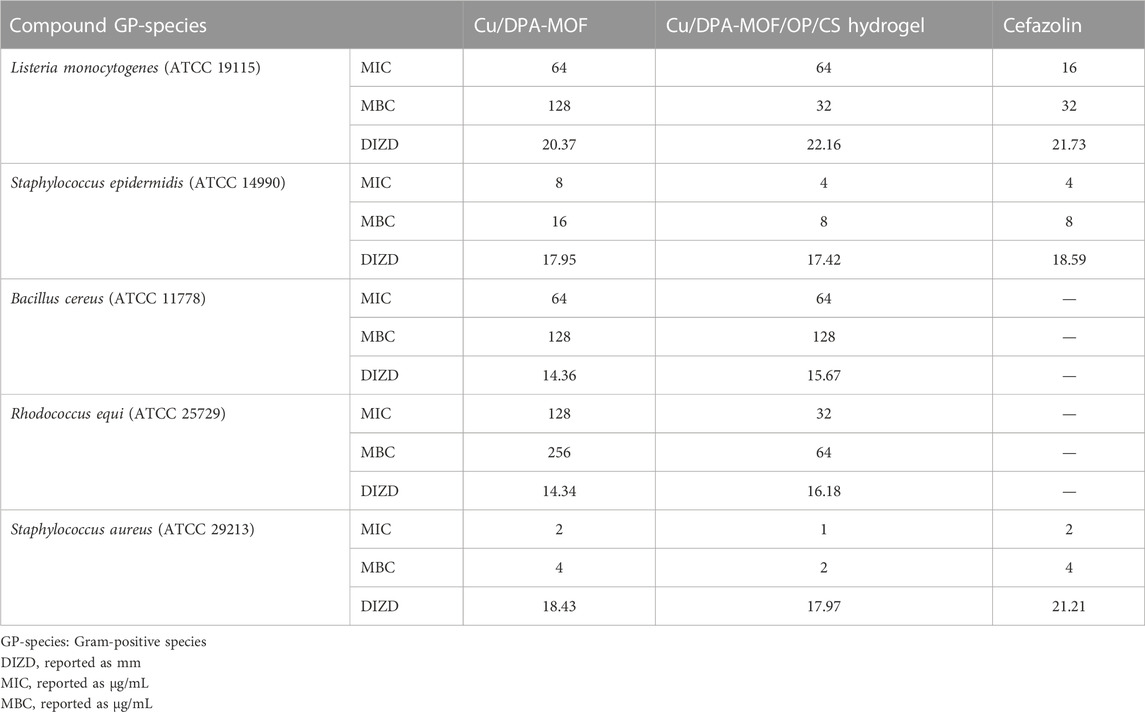
TABLE 2. Antimicrobial effects of Cu/DPA-MOF and Cu/DPA-MOF/OP/CS hydrogel on Gram-positive species.
During the investigation of antibacterial and antimicrobial activities, it is proved from the results reported in the tables that the effectiveness of Cu/DPA-MOF and Cu/DPA-MOF/OP/CS hydrogel was more than cefazolin and terbinafine, which are known drugs. As is known, copper is a disinfectant compound with significant antimicrobial properties. The observed powerful antimicrobial properties of the synthesized compounds can be attributed to the copper complex present in the structure, the nano-sized structures, and the high specific surface area.
Comparing the effects of Cu/DPA-MOF and Cu/DPA-MOF/OP/CS hydrogel shows that the Cu/DPA-MOF/OP/CS hydrogel was relatively more effective than Cu/DPA-MOF. The reason can be attributed to the specific surface area, and as mentioned, a higher specific surface area causes more effectiveness and efficiency in nanoparticles (Asiri et al., 2022; Suksatan et al., 2022; Zeraati et al., 2022).
4 Conclusion
Briefly, in this study, the novel Cu/DPA-MOF/OP/CS hydrogel was synthesized in mild conditions with remarkable physichochemical properties. To identify and confirm the structure of the novel hydrogel synthesized, techniques such as N2 adsorption/desorption isotherm, FT-IR spectrum, XRD patterns, SEM images, thermal stability curves, EDS elemental analysis, and mapping graph were used. Particle size in the nano range, high specific surface area, and high thermal stability were the essential features of the synthesized hydrogel. Next, the antimicrobial properties (antibacterial and antifungal) of the synthesized compounds were tested. To evaluate the antimicrobial properties of the synthesized compounds, the antimicrobial properties of cefazolin and terbinafine, which are well-known drugs in the market, were assessed and compared with the effects of synthetic nanoparticles. A comparison of the results showed that the synthesized compounds had higher antimicrobial properties than drugs. The observed significant antimicrobial properties of the synthesized compounds can be attributed to the efficient network complex present in the structure, the nano-sized structures, and the high specific surface area with stable porosity.
Data availability statement
The original contributions presented in the study are included in the article/Supplementary Material; further inquiries can be directed to the corresponding author.
Author contributions
Conceptualization, HJ; methodology, MA; software, AA; validation, MA; formal analysis, AD; investigation, AA; resources, WY; data curation, HA; writing—original draft preparation, SH; writing—review and editing, AA; visualization, AD; supervision, HJ; project administration, WY; funding acquisition, IA. All authors contributed to the article and approved the submitted version.
Acknowledgments
The authors express their gratitude to the Deanship of Scientific Research at King Khalid University for funding this work through the Large Research Group Project under grant number RGP.02/260/44.
Conflict of interest
The authors declare that the research was conducted in the absence of any commercial or financial relationships that could be construed as a potential conflict of interest.
Publisher’s note
All claims expressed in this article are solely those of the authors and do not necessarily represent those of their affiliated organizations, or those of the publisher, the editors, and the reviewers. Any product that may be evaluated in this article, or claim that may be made by its manufacturer, is not guaranteed or endorsed by the publisher.
References
Ahmadi, M., Ayyoubzadeh, S. M., Ghorbani-Bidkorbeh, F., Shahhosseini, S., Dadashzadeh, S., Asadian, E., et al. (2021). An investigation of affecting factors on MOF characteristics for biomedical applications: A systematic review. Heliyon 7, e06914. doi:10.1016/j.heliyon.2021.e06914
Al-Jumaili, A., Alancherry, S., Bazaka, K., and Jacob, M. V. (2017). Review on the antimicrobial properties of carbon nanostructures. Materials 10, 1066. doi:10.3390/ma10091066
Al-Rowaili, F. N., Jamal, A., Ba Shammakh, M. S., and Rana, A. (2018). A review on recent advances for electrochemical reduction of carbon dioxide to methanol using metal–organic framework (MOF) and non-MOF catalysts: Challenges and future prospects. ACS Sustain. Chem. Eng. 6, 15895–15914. doi:10.1021/acssuschemeng.8b03843
Asiri, M., Abdulsalam, A. G., Kahtan, M., Alsaikhan, F., Farhan, I., Mutlak, D. A., et al. (2022). Synthesis of new zirconium magnetic nanocomposite as a bioactive agent and green catalyst in the four-component synthesis of a novel multi-ring compound containing pyrazole derivatives. Nanomaterials 12, 4468. doi:10.3390/nano12244468
Babucci, M., Guntida, A., and Gates, B. C. (2020). Atomically dispersed metals on well-defined supports including zeolites and metal–organic frameworks: Structure, bonding, reactivity, and catalysis. Chem. Rev. 120, 11956–11985. doi:10.1021/acs.chemrev.0c00864
Bakhshi, A., Saravani, H., Rezvani, A., Sargazi, G., and Shahbakhsh, M. (2022). A new method of Bi-MOF nanostructures production using UAIM procedure for efficient electrocatalytic oxidation of aminophenol: A controllable systematic study. J. Appl. Electrochem. 52, 709–728. doi:10.1007/s10800-021-01664-9
Balagna, C., Francese, R., Perero, S., Lembo, D., and Ferraris, M. (2021). Nanostructured composite coating endowed with antiviral activity against human respiratory viruses deposited on fibre-based air filters. Surf. Coatings Technol. 409, 126873. doi:10.1016/j.surfcoat.2021.126873
De Araújo, E. L., Barbosa, H. F. G., Dockal, E. R., and Cavalheiro, É. T. G. (2017). Synthesis, characterization and biological activity of Cu (II), Ni (II) and Zn (II) complexes of biopolymeric Schiff bases of salicylaldehydes and chitosan. Int. J. Biol. Macromol. 95, 168–176. doi:10.1016/j.ijbiomac.2016.10.109
Dimitrijević, T., Novaković, I., Radanović, D., Novaković, S. B., Rodić, M. V., Anđelković, K., et al. (2020). Synthesis, spectral and structural characterization and biological activity of Cu(II) complexes with 4-(diethylamino)salicylaldehyde and α-diimines. J. Coord. Chem. 73, 702–716. doi:10.1080/00958972.2020.1740212
Elango, M., Deepa, M., Subramanian, R., and Mohamed Musthafa, A. (2018). Synthesis, characterization, and antibacterial activity of polyindole/Ag–Cuo nanocomposites by reflux condensation method. Polymer-Plastics Technol. Eng. 57, 1440–1451. doi:10.1080/03602559.2017.1410832
Gan, J., Galeckas, A., Venkatachalapathy, V., Riise, H. N., Svensson, B. G., and Monakhov, E. V. (2015). Study of photoluminescence properties of Cu x O thin films prepared by reactive radio frequency magnetron sputtering. MRS Online Proc. Libr. 1792, 15–17. doi:10.1557/opl.2015.596
Ghaffari, S. B., Sarrafzadeh, M. H., Salami, M., and Khorramizadeh, M. R. (2020). A pH-sensitive delivery system based on N-succinyl chitosan-ZnO nanoparticles for improving antibacterial and anticancer activities of curcumin. Int. J. Biol. Macromol. 151, 428–440. doi:10.1016/j.ijbiomac.2020.02.141
Ghanbari, T., Abnisa, F., and Daud, W. M. A. W. (2020). A review on production of metal organic frameworks (MOF) for CO2 adsorption. Sci. Total Environ. 707, 135090. doi:10.1016/j.scitotenv.2019.135090
Giliopoulos, D., Zamboulis, A., Giannakoudakis, D., Bikiaris, D., and Triantafyllidis, K. (2020). Polymer/metal organic framework (MOF) nanocomposites for biomedical applications. Molecules 25, 185. doi:10.3390/molecules25010185
Han, I., Choi, S. A., and Lee, D. N. (2022a). Therapeutic application of metal–organic frameworks composed of copper, cobalt, and zinc: Their anticancer activity and mechanism. Pharmaceutics 14, 378. doi:10.3390/pharmaceutics14020378
Han, S., Yao, A., Ding, Y., Leng, Q., Teng, F., Zhao, L., et al. (2022b). A dual-template imprinted polymer based on amino-functionalized zirconium-based metal–organic framework for delivery of doxorubicin and phycocyanin with synergistic anticancer effect. Eur. Polym. J. 170, 111161. doi:10.1016/j.eurpolymj.2022.111161
Hosseinzadegan, S., Hazeri, N., Maghsoodlou, M. T., Moghaddam-Manesh, M., and Shirzaei, M. (2020). Synthesis and evaluation of biological activity of novel chromeno [4, 3-b] quinolin-6-one derivatives by SO 3 H-tryptamine supported on Fe 3 O 4@ SiO 2@ CPS as recyclable and bioactive magnetic nanocatalyst. J. Iran. Chem. Soc. 17, 3271–3284. doi:10.1007/s13738-020-01990-3
Hu, X., An, A. K., and Chopra, S. S. (2022). Life cycle assessment of the polyvinylidene fluoride polymer with applications in various emerging technologies. ACS Sustain. Chem. Eng. 10, 5708–5718. doi:10.1021/acssuschemeng.1c05350
Jasim, S. A., Hadi, J. M., Jalil, A. T., Opulencia, M. J. C., Hammid, A. T., Tohidimoghadam, M., et al. (2022). Electrospun Ta-MOF/PEBA nanohybrids and their CH4 adsorption application. Front. Chem. 10, 868794. doi:10.3389/fchem.2022.868794
Jo, J. H., Kim, H. C., Huh, S., Kim, Y., and Lee, D. N. (2019). Antibacterial activities of Cu-MOFs containing glutarates and bipyridyl ligands. Dalton Trans. 48, 8084–8093. doi:10.1039/c9dt00791a
Kasinathan, K., Murugesan, B., Pandian, N., Mahalingam, S., Selvaraj, B., and Marimuthu, K. (2020). Synthesis of biogenic chitosan-functionalized 2D layered MoS2 hybrid nanocomposite and its performance in pharmaceutical applications: Iin-vitro antibacterial and anticancer activity. Int. J. Biol. Macromol. 149, 1019–1033. doi:10.1016/j.ijbiomac.2020.02.003
Khan, M. E., Han, T. H., Khan, M. M., Karim, M. R., and Cho, M. H. (2018). Environmentally sustainable fabrication of Ag@ g-C3N4 nanostructures and their multifunctional efficacy as antibacterial agents and photocatalysts. ACS Appl. Nano Mater. 1, 2912–2922. doi:10.1021/acsanm.8b00548
Kiadeh, S. Z. H., Ghaee, A., Farokhi, M., Nourmohammadi, J., Bahi, A., and Ko, F. K. (2021). Electrospun pectin/modified copper-based metal–organic framework (MOF) nanofibers as a drug delivery system. Int. J. Biol. Macromol. 173, 351–365. doi:10.1016/j.ijbiomac.2021.01.058
Li, D. Q., Li, J., Dong, H. L., Li, X., Zhang, J. Q., Ramaswamy, S., et al. (2021a). Pectin in biomedical and drug delivery applications: A review. Int. J. Biol. Macromol. 185, 49–65. doi:10.1016/j.ijbiomac.2021.06.088
Li, R., Chen, T., and Pan, X. (2021b). Metal–organic-framework-based materials for antimicrobial applications. ACS Nano 15, 3808–3848. doi:10.1021/acsnano.0c09617
Li, X., Xu, Y., Ouyang, D., Ye, K., Chen, Y., Li, Q., et al. (2023). Copper-and iodine-doped nanozymes with simulated enzyme activity and efficient antifungal activity against Candida albicans. Biochem. Eng. J. 191, 108791. doi:10.1016/j.bej.2022.108791
Lin, C., Guo, X., Mo, F., and Sun, D. (2023). Different dimensional copper-based metal–organic frameworks with enzyme-mimetic activity for antibacterial therapy. Int. J. Mol. Sci. 24, 3173. doi:10.3390/ijms24043173
Marković, D., Deeks, C., Nunney, T., Radovanović, Ž., Radoičić, M., Šaponjić, Z., et al. (2018). Antibacterial activity of Cu-based nanoparticles synthesized on the cotton fabrics modified with polycarboxylic acids. Carbohydr. Polym. 200, 173–182. doi:10.1016/j.carbpol.2018.08.001
Nurazzi, N., Asyraf, M., Khalina, A., Abdullah, N., Aisyah, H., Rafiqah, S. A., et al. (2021). A review on natural fiber reinforced polymer composite for bullet proof and ballistic applications. Polymers 13, 646. doi:10.3390/polym13040646
Otter, J., Mutters, N., Tacconelli, E., Gikas, A., and Holmes, A. (2015). Controversies in guidelines for the control of multidrug-resistant Gram-negative bacteria in EU countries. Clin. Microbiol. Infect. 21, 1057–1066. doi:10.1016/j.cmi.2015.09.021
Rascón-Chu, A., Gomez-Rodriguez, G. H., Carvajal-Millan, E., and Campa-Mada, A. C. (2019). Pectin in drug delivery applications. Nat. polysaccharides drug Deliv. Biomed. Appl. 185, 249–262. doi:10.1016/b978-0-12-817055-7.00010-8
Razavi, S. a. A., and Morsali, A. (2019). Linker functionalized metal-organic frameworks. Coord. Chem. Rev. 399, 213023. doi:10.1016/j.ccr.2019.213023
Salama, H. E., and Aziz, M. S. A. (2020). Novel biocompatible and antimicrobial supramolecular O-carboxymethyl chitosan biguanidine/zinc physical hydrogels. Int. J. Biol. Macromol. 163, 649–656. doi:10.1016/j.ijbiomac.2020.07.029
Saqezi, A. S., Kermanian, M., Ramazani, A., and Sadighian, S. (2022). Synthesis of graphene oxide/iron oxide/Au nanocomposite for quercetin delivery. J. Inorg. Organomet. Polym. Mater. 32, 1541–1550. doi:10.1007/s10904-022-02259-3
Sargazi, G., Afzali, D., and Mostafavi, A. (2018). An efficient and controllable ultrasonic-assisted microwave route for flower-like Ta (V)–MOF nanostructures: Preparation, fractional factorial design, DFT calculations, and high-performance N 2 adsorption. J. Porous Mater. 25, 1723–1741. doi:10.1007/s10934-018-0586-3
Suksatan, W., Kazemzadeh, P., Afzali, D., Moghaddam-Manesh, M., Chauhan, N. P. S., and Sargazi, G. (2022). A controllable study on ultrasound assisted synthesis of a novel Ni/Zn based hybrid MOF nanostructures for Dextranase immobilization. Inorg. Chem. Commun. 139, 109410. doi:10.1016/j.inoche.2022.109410
Sun, Y., Jiang, X., Liu, Y., Liu, D., Chen, C., Lu, C., et al. (2021). Recent advances in Cu (II)/Cu (I)-MOFs based nano-platforms for developing new nano-medicines. J. Inorg. Biochem. 225, 111599. doi:10.1016/j.jinorgbio.2021.111599
Sun, Z. (2019). Hyperbranched polymers in modifying natural plant fibers and their applications in polymer matrix composites—A review. J. Agric. food Chem. 67, 8715–8724. doi:10.1021/acs.jafc.9b03436
Wani, W. A., Prashar, S., Shreaz, S., and Gomez-Ruiz, S. (2016). Nanostructured materials functionalized with metal complexes: In search of alternatives for administering anticancer metallodrugs. Coord. Chem. Rev. 312, 67–98. doi:10.1016/j.ccr.2016.01.001
Zaky, M. F., Megahed, M. A., Hammady, T. M., Gad, S., Ghorab, M. M., and El-Say, K. M. (2023). Tailoring apixaban in nanostructured lipid carrier enhancing its oral bioavailability and anticoagulant activity. Pharmaceutics 15, 80. doi:10.3390/pharmaceutics15010080
Zare, E. N., Jamaledin, R., Naserzadeh, P., Afjeh-Dana, E., Ashtari, B., Hosseinzadeh, M., et al. (2019). Metal-based nanostructures/PLGA nanocomposites: Antimicrobial activity, cytotoxicity, and their biomedical applications. ACS Appl. Mater. interfaces 12, 3279–3300. doi:10.1021/acsami.9b19435
Zeraati, M., Moghaddam-Manesh, M., Khodamoradi, S., Hosseinzadegan, S., Golpayegani, A., Chauhan, N. P. S., et al. (2022). Ultrasonic assisted reverse micelle synthesis of a novel Zn-metal organic framework as an efficient candidate for antimicrobial activities. J. Mol. Struct. 1247, 131315. doi:10.1016/j.molstruc.2021.131315
Keywords: hydrogel, oxidized pectin, chitosan, copper metal–organic framework, antimicrobial study
Citation: Jasim Al-Khafaji HH, Alsalamy A, Abed Jawad M, Ali Nasser H, Dawood AH, Hasan SY, Ahmad I, Gatea MA and Younis Albahadly WK (2023) Synthesis of a novel Cu/DPA-MOF/OP/CS hydrogel with high capability in antimicrobial studies. Front. Chem. 11:1236580. doi: 10.3389/fchem.2023.1236580
Received: 07 June 2023; Accepted: 31 July 2023;
Published: 11 August 2023.
Edited by:
Michelina Soccio, University of Bologna, ItalyReviewed by:
Hossein Molavi, Sharif University of Technology, IranSomayeh Sadighian, Zanjan University of Medical Sciences, Iran
Copyright © 2023 Jasim Al-Khafaji, Alsalamy, Abed Jawad, Ali Nasser, Dawood, Hasan, Ahmad, Gatea and Younis Albahadly. This is an open-access article distributed under the terms of the Creative Commons Attribution License (CC BY). The use, distribution or reproduction in other forums is permitted, provided the original author(s) and the copyright owner(s) are credited and that the original publication in this journal is cited, in accordance with accepted academic practice. No use, distribution or reproduction is permitted which does not comply with these terms.
*Correspondence: Ali Alsalamy, YWxpaGFzaGltYWxzYWxhbXk3OEBnbWFpbC5jb20=
 Hanadi Hadi Jasim Al-Khafaji1
Hanadi Hadi Jasim Al-Khafaji1 Ali Alsalamy
Ali Alsalamy